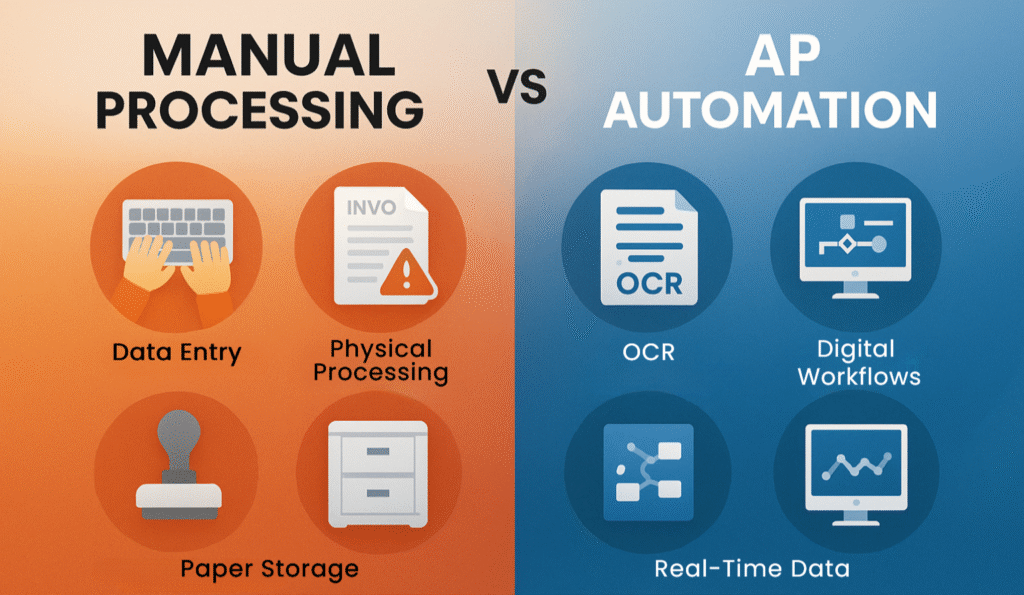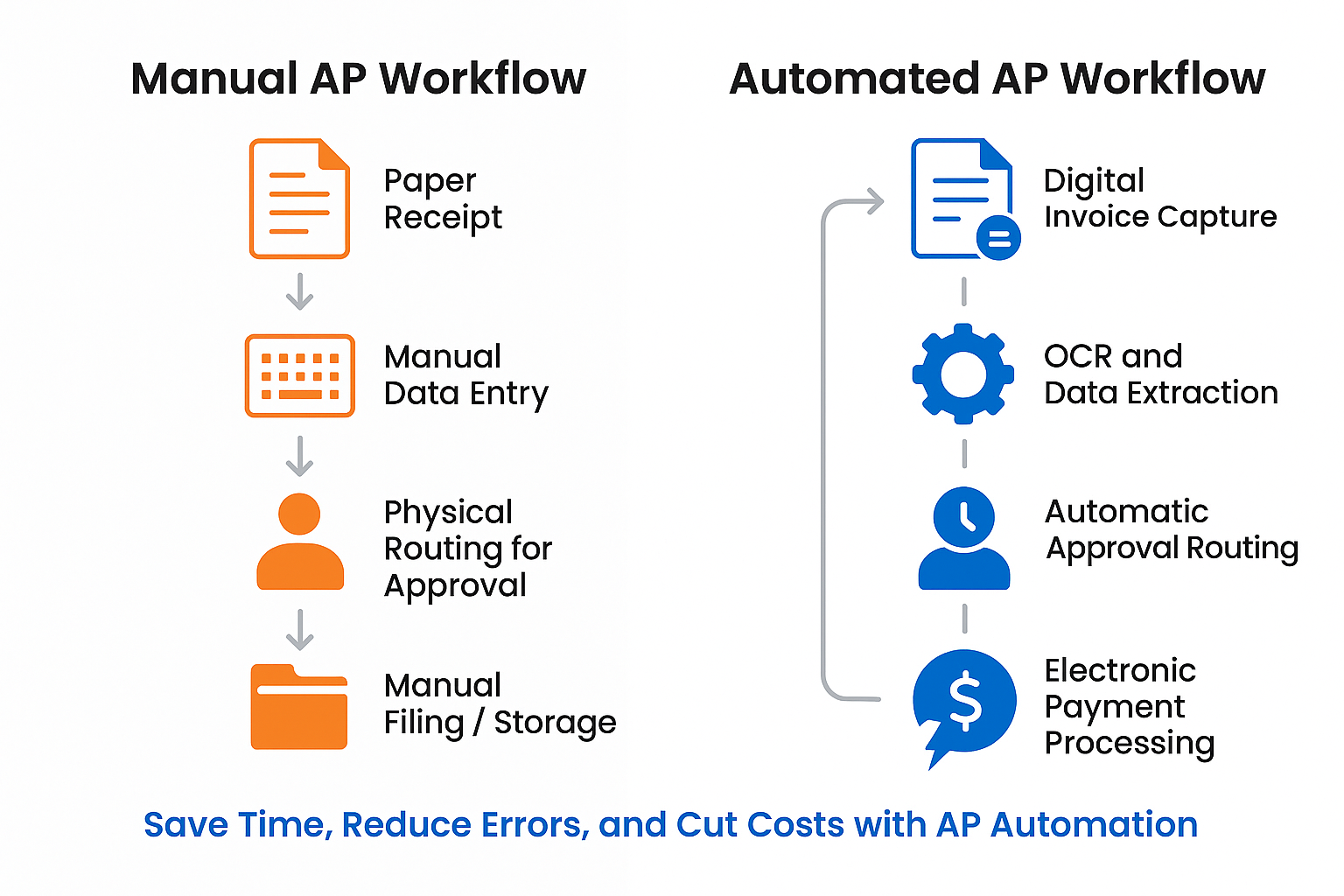Accounts payable (AP) is a critical function in any business, but managing it manually can lead to inefficiencies, high costs, and delays. As businesses scale, the complexity of financial workflows increases, making traditional paper-based methods less effective. AP automation offers a solution to streamline financial operations, reduce errors, and lower costs. In this article, we’ll compare AP automation to manual processing in terms of time and cost savings, and explain why automating AP processes can enhance your financial workflows.

More businesses are adopting AP automation to replace outdated manual processes. With automation, businesses can process invoices faster, improve accuracy, and free up resources for more strategic tasks. AP automation enhances financial operations by reducing manual data entry and speeding up approval workflows. It allows businesses to reduce costs and make better financial decisions, improving overall efficiency.
Manual AP processing is time-consuming and error-prone. Paper invoices require manual data entry, physical approvals, and extensive filing, which leads to delays and increased labor costs. AP automation digitizes and automates invoice receipt, approval routing, and payment processing, offering a more efficient solution.
.Manual AP processes are prone to errors, such as incorrect data entry or misplaced invoices, which can delay payments and lead to costly mistakes. AP automation uses Optical Character Recognition (OCR) technology to extract key information from invoices accurately, ensuring data is captured correctly. Automation reduces the need for manual intervention, minimizing errors and speeding up processing times.
Moreover, automation accelerates invoice approval by routing invoices to the appropriate personnel quickly, eliminating delays caused by physical paperwork or email-based approvals. This faster approval process helps businesses make payments on time and maintain better relationships with vendors.
The approval process in manual AP workflows often involves routing invoices through multiple departments for signatures. This can be slow and inefficient, especially if key employees are unavailable. AP automation replaces this with digital workflows, routing invoices to the right approvers automatically. These workflows can be customized to meet the needs of the business, ensuring invoices are approved quickly and accurately.
By reducing approval times, AP automation allows businesses to make faster decisions, improve efficiency, and reduce cycle times. This leads to quicker payments to vendors and stronger business relationships.
Timely payments are crucial for maintaining strong vendor relationships. Manual AP processes can delay payments, leading to strained relationships and late payment penalties. AP automation speeds up invoice processing and approval, ensuring that payments are made on time. This enhances vendor trust and can even lead to better payment terms, discounts, and service levels from vendors.
The differences between manual and automated AP workflows are crucial in assessing their impact on a business. Manual processes involve several steps, including data entry, document routing, and approval procedures, which require significant labor and are prone to inefficiencies. In contrast, AP automation digitizes these processes, reducing manual labor, improving accuracy, and speeding up workflow.
Manual AP processing is not only time-consuming but also costly. Businesses spend significant resources on labor, paper, printing, storage, and filing. These inefficiencies often lead to higher operational costs and errors that require additional time and resources to correct.

Manual invoice processing involves receiving paper invoices, entering data manually, routing documents for approval, and storing invoices in filing cabinets. These steps are labor-intensive, time-consuming, and prone to errors. Additionally, paper-based processes result in higher costs for printing, storage, and filing.
Beyond labor and material costs, manual AP workflows can also lead to costly mistakes. For example, late payments can incur penalties, and errors in data entry can lead to overpayments or missed discounts. These errors can negatively impact the business’s bottom line.
AP automation eliminates the need for manual data entry and paper handling by digitizing invoices and routing them automatically for approval. This not only reduces labor costs but also speeds up the entire process. Businesses can process invoices more quickly, leading to faster decision-making and less time spent on administrative tasks.
By automating these tasks, businesses can allocate resources more efficiently, freeing up employees for higher-value activities. This reduces labor costs and helps improve overall productivity.
One of the most significant advantages of AP automation is access to real-time data. With manual processes, businesses rely on periodic reports, which can quickly become outdated. AP automation provides real-time visibility into invoice status, approval stages, and payment schedules. This access to live data enables businesses to make faster, more informed financial decisions.
Real-time data also helps businesses manage cash flow, track spending, and make accurate financial projections. With better insights into financial transactions, businesses can optimize their resources and improve cash flow management.
AP automation leads to significant cost savings by reducing the labor needed for manual tasks and eliminating paper-based processes. Businesses save money on materials, printing, and storage while also reducing the likelihood of errors that can lead to overpayments or missed discounts. Automation also helps businesses avoid costly late payment penalties by ensuring invoices are processed and paid on time.
By eliminating paper-based processes, AP automation cuts down on the costs associated with printing, mailing, and storing invoices. Digital workflows streamline the process, removing the need for paper, filing cabinets, and physical storage, resulting in significant savings on materials and office space.
Late payments can lead to penalties, damaged vendor relationships, and missed opportunities for early payment discounts. AP automation helps businesses stay on top of payment due dates, ensuring timely payments and reducing the risk of late fees. Additionally, many AP automation systems feature fraud detection capabilities, preventing fraudulent invoices and unauthorized payments.
Modern AP automation solutions incorporate artificial intelligence (AI) and machine learning to improve financial accuracy and decision-making. AI-powered systems analyze historical data to identify patterns, predict cash flow, and help businesses make more informed decisions. This enhances financial planning and enables businesses to make smarter, data-driven choices.
When selecting an AP automation system, businesses should consider the following features:
Best Practices for a Smooth AP Automation Adoption
To successfully adopt AP automation, businesses should:
AP automation offers substantial time and cost savings compared to manual processing. By reducing errors, speeding up approval cycles, and lowering operational costs, businesses can improve their financial workflows and maintain better vendor relationships. In today’s fast-paced business environment, AP automation is not just a trend—it’s a necessity for staying competitive.
Ready to streamline your financial workflows and save time and money? American Business Solutions specializes in AP Automation, helping businesses eliminate inefficiencies, reduce errors, and cut costs.
Unlock the power of automation—enhance your AP process with real-time data, faster approvals, and reduced operational expenses.
Contact us today for a free consultation and see how our AP automation solutions can improve your financial operations and vendor relationships.
Save time, reduce costs, and boost efficiency with American Business Solutions’ ISDocs AP Automation!